Clinical
Division of General, Geriatric, Palliative & Hospital Medicine
CLINICAL ACTIVITIES
General Medicine

UVA Health System’s Department of Medicine and Department of Family Medicine together opened the UVA Primary and Specialty Care Pantops Integrative Medicine with a focus on health and wellness of body, mind, and spirit.
The General Medicine section, led by Mohan Nadkarni, MD, focuses on the care of adults ages 18 and over. Its emphasis is on preventive care and fostering long-term relationships between patients and physicians. In April 2015, the division launched UVA Primary and Specialty Care Pantops Integrative Medicine, located at 650 Peter Jefferson Parkway. This innovative practice with four providers is a joint effort between Family Medicine and General Internal Medicine. Directed by John Leiner, MD, the practice offers same-day visits, extended hours and responsive care for patients from the prenatal period to senior adulthood. Holistic services offered or slated to be offered at the practice include acupuncture, yoga medicine, massage therapy and nutrition. Parking is free and immediately adjacent to the practice, which is also conveniently located at the intersection of U.S. Route 250 and Interstate 64.
Led by Ira Helenius, MD, University Medical Associates (UMA) serves as the continuity practice for all 100 Department of Medicine (DOM) medical residents. The largest of the division’s primary care practices, UMA is located on the main grounds of UVA Health System. In July 2014, the practice successfully transitioned with the Internal Medicine residency program to a “3+1” schedule. Residents’ inpatient and outpatient assignments are now separated, and every fourth week is spent in the ambulatory setting without interference from inpatient duties. This “diastole” week is a welcome break for the residents and gives them a better opportunity to strengthen their ambulatory skills. The change ensures the entirety of the office-based ambulatory curriculum is provided to every resident.
UMA developed a task force to work on improving continuity between the patient and primary care physician — an important element for patient and resident satisfaction. Residents, schedulers, attendings and support staff met multiple times to identify and remove barriers and were able to improve continuity numbers from 50 percent to 65 percent over the course of four months. The clinic is currently on track to achieve its target of 75 percent.
UMA was also one of seven clinics chosen to start quality improvement projects intended to enhance the achievement of ACO metrics in the outpatient setting. Using the Be Safe structure, multidisciplinary teams (nurses, medical assistants, attendings and consultant “coaches”) created standard workflows involving depression screening (using PHQ2), in turn increasing patient screenings from 1 percent to 24 percent. The standard workflows created by this project will now be distributed and implemented at other outpatient clinics in UVA Health System.

Video: Clint Merritt, MD, discusses his work as director of the hospitalist team at UVA Medical Center.
UMA also adopted a new physician scheduling software called QGenda, which was previously used only in the Hospital Medicine section. An Internet browser-based system, it allows the division to produce an improved physician work schedule to accommodate difficult and diverse business rules. Full utilization of the system across all sections within the division will lead to seamless scheduling and better assistance with faculty availability and clinical needs.
The division’s other major Charlottesville-based clinic, University Physicians Charlottesville (UPC), is located in Fontaine Research Park. Led by Kenneth Ballew, MD, UPC continues to expand its ambulatory internal medicine presence. North of Charlottesville, University Physicians Orange (UPO) provides clinical care to a largely rural population. Lien Dame, MD, serves as the UPO clinic’s medical director.
Hospital Medicine
With the goal of providing seamless, coordinated care, Hospital Medicine is at the forefront of all of the big issues in healthcare. Under the direction of section head George Hoke, MD, and medical director Clinton Merritt, MD, the section of Hospital Medicine provides care at both University Hospital and Transitional Care Hospital (TCH), and serves as a training ground for future hospitalists. Providing general medicine consultation to the surgical services and direct hospital care in the general medicine wards, the hospitalist program maintains outstanding quality statistics and a demonstrated reduction of mortality rates.
In September 2014, the hospitalist program launched a new Orthopedic Co-Management Service — a service long desired by leadership at UVA Medical Center and in the Department of Orthopaedic Surgery. A dedicated hospitalist is assigned to the Orthopaedic Surgery patient population during the day shift. This physician assesses and triages patients presenting to the Emergency Department with orthopedic disorders, performs preoperative evaluations, assumes responsibility for management of chronic medical comorbidities and acute complications, and assists in care transitions at the time of discharge. Initial feedback from the Orthopaedic faculty and nursing staff has been very positive and the first nine months saw steady growth in patient volumes. During FY 2016, the section will be focusing on improving outcomes in patients experiencing hip fractures.
Under the leadership of medical director John Cramer, MD, hospitalists at TCH have focused on eliminating hospital-acquired infections, with improved performance resulting in the TCH team exceeding peer group average in all categories. Their work was honored when they received the Charles Brown L. Award for Quality Improvement.
Geriatrics

Geriatrician Laurie Archbald-Pannone, MD, was featured in ACAC’s “Physician Referral Exercise Program.”
Under the direction of Mark Newbrough, MD, the Geriatrics section operates four well-established community-based practices in the Charlottesville area. Providing outpatient care, University Physicians at JABA, led by Laurie Archbald-Pannone, MD, MPH, AGSF, recently doubled its sessions to meet the increasing number of elders in the community. Available five days a week, the clinic provides primary geriatric care, geriatric consultation and a recently added frailty-focused clinic. University Physicians at JABA was also featured as VIP for the ACAC Physician Referred Exercise Program (p.r.e.p.).
Seki Balogun, MBBS, CMD, FACP, AGSF, serves as medical director and primary geriatrician at Westminster Canterbury of the Blue Ridge. The retirement community has about 400 residents age 65 years and above at various levels of care, including independent living, assisted living, advanced dementia care, skilled nursing and long-term nursing home care. In conjunction with two nurse practitioners, the facility has expanded clinical services by about 40 percent, with an increase from three days a week to five full days a week.
Diane Snustad, MD, FACP, has served as medical director at The Colonnades — a Sunrise Senior Living community — since it opened its doors in 1991. The full-service retirement community includes assisted-living and nursing home facilities as well as Colonnades Medical Associates, a UVA outpatient clinic that provides full internal medicine and primary care services, as well as geriatric consultation.
Enrollment at Blue Ridge PACE has grown steadily since it opened in March 2014 and currently stands at 74 participants. The program, led by Mark Newbrough, MD, had a deficiency-free initial CMS survey in November 2014 and is on track in terms of census growth and quality of care. A second CMS survey is scheduled for November 2015. Census growth has created the need to add additional providers. As such, Blue Ridge PACE will be recruiting a nurse practitioner to join the team in the coming year.
Relationships between the three partners who own and manage Blue Ridge PACE continue to grow and mature, as do relationships between Blue Ridge PACE and our care partners throughout our service area, including the entire UVA Health System. Blue Ridge PACE is becoming a more dynamic partner in the educational missions of the University and expects to be a very active site for clinical and service learning over the coming year. The assistance provided by the UVA Emergency Room team and the Department of Medicine faculty, residents and staff deserves special attention. Everyone has been supportive of the distinct needs of our participants, and has worked in a collaborative way with the PACE interdisciplinary team to facilitate care.
Palliative
The Palliative Medicine section, led by Leslie Blackhall, MD, is dedicated to creating clinical pathways that identify patients with life-limiting illnesses, with the aim of improving quality of life for these patients and ensuring that they receive the care they need, at the time and place they need it. Palliative services, which focus on defining the goals of care and include symptom management and advance care planning, are available for hospitalized patients at the University Hospital and Transitional Care Hospital seven days per week. On the outpatient side, the Palliative Clinic at Emily Couric Clinical Cancer Center is open five days per week and serves patients with cancer at any stage of their illness, including those with curable cancers and survivors with symptoms related to their cancer treatments.
Funded by a CMS Innovation Award, the palliative section launched the CARE Track program. Clinicians worked with oncologists to transform the care of patients with advanced cancer through utilization of UVa MyCourse. This patient-reported outcome tool includes a questionnaire completed at each visit by patients with advanced cancers, and measures symptoms and functional status. The results are then incorporated in the patient’s electronic medical record in real time, and displayed with triggers for those with worsening symptoms or declining functional status. The triggers also prompt a review by a multidisciplinary team, and referral for appropriate services.
This intervention has resulted in dramatic decreases in hospitalization at end of life. The success of the CARE Track program within oncology led to funding by the Buchanan Endowment to expand the program to cardiac heart failure patients with increased symptoms and frequent hospitalizations. Service expansion began in early summer 2014.
Clinical Productivity
The division continued to experience growth in clinical productivity with the majority of the increase seen in the areas of Hospital and Palliative Medicine. [Table: Division of General, Geriatric, Palliative & Hospital Medicine – Charges, Collections & RVUs, FY 2015]
Quality & Patient Safety
Under the direction of John Voss, MD, the Department of Medicine’s Vice Chair for Quality and Safety, the division has advanced numerous safety initiatives. In addition to providing leadership in key areas such as sepsis, aspiration, and general medicine geography, the division trialed an innovative rounds on fall reduction in one of the general medicine wards; collaborated with the Department of Orthopaedic Surgery on the implementation of a new care pathway for hip fractures; and worked with the hospital pharmacy on A3 to standardize processes for medication reconciliation. Other activities included:
- Leadership for the Accountable Care Organization (ACO) strategic initiative related to operations and informatics
- Developing standard work procedure for depression screening in ACO clinics
- Launching panel-manager-assisted population management in the UMA clinic [more on panel management here]
The palliative section received a Buchanan Award for its project “Comprehensive Assessment with Rapid Evaluation and Treatment (CARE Track) for Advanced Oncology and CHF,” and will use patient-reported outcomes, based on tools from the National Institute of Health’s Patient-Reported Outcomes Measurement System (“PROMIS”) that are built into EPIC, to help guide clinical care for seriously ill cancer and cardiology patients.


